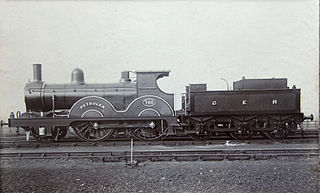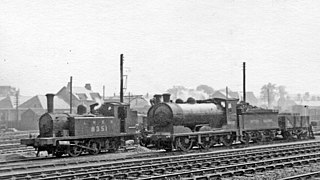The Highland Railway began as the Inverness and Nairn Railway, which operated the other lines which became part of the Highland Railway on its formation in 1865. For post-1870 locomotives, see Locomotives of the Highland Railway.

The NBR C Class is a class of 0-6-0 steam locomotives designed by Matthew Holmes for freight work on the North British Railway (NBR). They were introduced in 1888 with inside cylinders and Stephenson valve gear. A total of 168 locomotives was built, of which 123 came into British Railways ownership at nationalisation in 1948. This was the last class of steam engine in service in Scotland.

The NBR K Class is a class of 4-4-0 steam locomotive of the North British Railway. The first batch was designed by Matthew Holmes in 1902 and had 6-foot-6-inch (1.981 m) driving wheels for express passenger work. Three more batches were designed by William P. Reid with 6-foot-0-inch (1.829 m) driving wheels for mixed traffic work. This included perishable goods, such as fish from Mallaig and Aberdeen. They had inside cylinders and Stephenson valve gear. The D34 locomotives, commonly known as Glen Class, were built with superheaters. The LNER later fitted superheaters to all D26, D32, and D33 engines as well. All engines of the K class are sometimes known as Glen Class, although the designation is strictly reserved to the fourth (D34) batch.

The Great Northern Railway (GNR) Class O2 was a class of three-cylinder 2-8-0 steam locomotives designed by Nigel Gresley for freight work and built by the GNR from 1921. Further examples were built by the London and North Eastern Railway (LNER) from 1924.

The GER Class T19 was a class of 2-4-0 steam tender locomotives designed by James Holden for the Great Eastern Railway. Some were later rebuilt with larger boilers while others were rebuilt with both larger boilers and a 4-4-0 wheel arrangement. Unusually, both the 2-4-0 and 4-4-0 rebuilds were classified as GER Class T19 Rebuilt. All the 2-4-0s had been withdrawn by 1920 so only the 4-4-0s passed to the London and North Eastern Railway in 1923 and these became the LNER Class D13.
William Paton Reid, CBE was apprenticed to the Cowlairs railway works of the North British Railway in 1879 and was Locomotive Superintendent from 1903 to 1919. He was appointed a CBE in 1920. He was born, and died, in Glasgow, Scotland.
Walter Chalmers was a Scottish engineer. He followed his father into the North British Railway, starting as an apprentice at Cowlairs railway works. In 1904 he became Chief Draughtsman and, from 1920 to 1922, he was Chief Mechanical Engineer.

The Great Northern Railway Class H2 and H3 was a class of 2-6-0 steam locomotive designed for mixed-traffic work.
The NBR Class M was a class of 4-4-0 steam locomotive of the North British Railway. The class was created during the tenures of William P. Reid and Walter Chalmers by rebuilding three earlier types, the "574", "633", and "729", which had all been designed by Matthew Holmes, and shared many features in common. A total of 48 were produced.
The Midland Railway Johnson 0-6-0 were a class of locomotives serving Britain's Midland Railway system in the late 19th and early 20th centuries. Between 1875 and 1908 the Midland Railway, under the control of locomotive superintendents Samuel Waite Johnson and Richard Deeley, ordered 935 goods tender engines of 0-6-0 type, both from the railway's own shops at Derby and various external suppliers. Although there were many variations between different batches both as delivered and as successively rebuilt, all 935 can be regarded as a single series, one of the largest classes of engine on Britain's railways. The locomotives served as late as 1964, but none of them now survive.

The London and North Eastern Railway Class A2/2 was a class of six 4-6-2 steam locomotives rebuilt by Edward Thompson in 1943 and 1944 from his predecessor's P2 Class of 2-8-2 express passenger locomotives. The rebuilds were not particularly successful and all were withdrawn and scrapped between 1959 and 1961.

The Great Central Railway 9K and 9L classes were two related classes of 4-4-2T Atlantic steam locomotives. They were both intended for suburban passenger services. After the 1923 Grouping, they served the LNER as classes C13 and C14.

The NBR 224 and 420 Classes consisted of six steam locomotives of the 4-4-0 wheel arrangement built by the North British Railway (NBR) in 1871 and 1873. No. 224 had three claims to fame: it was the first inside-cylinder 4-4-0 engine to run in Great Britain; it was the locomotive involved in the Tay Bridge disaster; and after rebuilding in 1885, it was the only compound-expansion locomotive on the NBR, and one of just three tandem compounds in Britain.

The NBR S Class was a class of 0-6-0 steam locomotive designed by William Paton Reid for freight work on the North British Railway. The engines were initially designated as B class, being a development of the standard B class locomotives designed by Reid some eight years previously, and represented the culmination of a long evolution on the NBR of powerful 0-6-0 freight engines. The new locomotives were introduced in 1914 and had superheaters, inside cylinders and piston valves operated by Stephenson valve gear.

The NBR D Class was a class of 0-6-0 tank locomotives designed by Matthew Holmes for short distance freight, station pilot, and heavy shunting duties on the North British Railway.

The NBR A Class (London and North Eastern Railway Classes N14 and N15 were the standard 0-6-2 tank locomotives designed by William P. Reid for freight duties on the North British Railway. The LNER regarded the original locomotives as two separate classes. The final batch of locomotives was on order at the time of the grouping in 1923.

The North British Atlantic, later known as NBR Class H, and then as LNER Class C11 was a class of 4-4-2 steam locomotive of the North British Railway. The class was designed by William P. Reid, Locomotive Superintendent of the NBR, and entered service under his direction. They were the heaviest, longest, and most powerful locomotives ever employed on the North British Railway.
The NBR Class D was a class of 0-6-0 steam locomotive of the North British Railway, often known as the Wee Drummonds. The class was designed by Dugald Drummond. A total of 101 were produced.

The NBR F Class was a class of 0-6-0 tank locomotives, designed by William P. Reid on the North British Railway. They were used for dockyard shunting duties.
The GNR Classes D2 and D3 were two classes of 51 4-4-0 steam locomotives designed by Henry Ivatt for the Great Northern Railway (GNR). They were the first 4-4-0s to be introduced by the GNR, and Ivatt's first original design for the railway as well.













